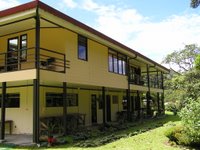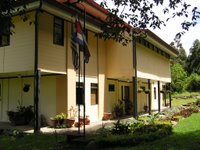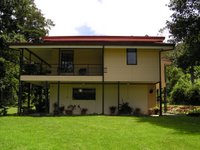


David says: Bienvenidos! You made it to our blog (whatever that means). Regardless, we are not to here to discuss what a blog is or is not. We are here to share la pura vida (pure life) of Costa Rica with you. And Sarah and I are very happy to know that you are checking this out. We encourage you to do so every now and then to see what we are up to and up against.
No better place to start than the beginning, huh? We arrived in Costa Rica on Monday, September 11th. Three ticos working for Moaba picked us up and loaded our luggage. (Only it turns out only two of them were actually hired by us and when we got in the van the third one confessed his scam and asked for a tip. So, I tipped him. He was really nice.) We stopped at a Hiper Mas outside of San Jose to buy groceries for up to a month. You see, we are currently without a car and we live about a 10km and a 2000 ft. elevation hike to the nearest bus stop that would then take us 1 ½ hours to the nearest grocery store. So, we really had to stock up. And that is no easy task for two young adults who have never really cooked for themselves before and are buying groceries that don’t look or read the same as they do in the states. But, we used our previous Costa Rican and Spanish experience to the fullest and found the mayonesa and every good fruit juice flavor we could. After a thorough food assessment upon our arrival at our new home we realized we did a pretty good job.
Anyway, after Hiper Mas, we enjoyed a beautiful two hour ride up, up, and up as we headed southwest from San Jose toward the Talamanca mountain range of southern Costa Rica on the Pacific slope. The tropics were a beautiful site as the air temperature kept getting colder and colder. And when we started descending into the Savegre valley surrounded by montane cloud forests worthy of a National Geographic special we knew we had arrived, not into maturity or anything like that, but into our new home. It is hard to describe how there can be so many hues of green that cannot be explained and yet are so different from one another. And it is hard to explain how you can see the canopy tops of these magnificient forests and you know that you are just seeing the outer shell of a world incredibly diverse waiting to be explored and experienced. It was the first time Sarah has made the drive down to San Gerardo de Dota and it was my third. It hasn’t lost any thought-stopping qualities over time. I was so excited to see Sarah experience it for the first time and for us to be there together.
San Gerardo de Dota, a very quiet community of about 130 people who live and share very different lives, is where our stop was. The diversity of the people’s lives does not compare to the biodiversity of the forest, but they do warrant some figuring out. The community exists because of Efrain Chacon and a few others who settled in the valley in the 1950s only to become extremely successful dairy farmers. As the valley was slowly on its way to complete deforestation and loss of all its biodiversity, Efrain had the love and foresight to see that the nature was his family’s most valuable asset. He sold his world-renowned cows, converted the cleared land to orchards, stopped cutting down the forest and made a go at eco-tourism, utilizing the land’s best resources. I guess it is kind of a Field of Dreams story in a way. The people started coming and now the majority of the economy in the valley is eco-tourism. It is a conservation story of extreme value and victory. The story continues as there is a new national park being developed that will protect a large chunk of land. All of this has not been without problems or imperfections, of course, but the general motivation and idea is right on.
So that is where we are. We are Field Station Managers of the Quetzal Educational Research Center (QERC) at 7000 ft in the cloud forests of San Gerardo de Dota, owned and operated by Southern Nazarene University. The research center is dedicated to the education of Christian students in stewardship principles, conservation driven research, and a community connection to all of these ideas as it pertains to those in this valley. It’s pretty sweet! God has blessed us to be apart of what is going on here and it is going to be an honor to struggle through the risks and rewards of getting QERC functioning as it was dreamt to be.
And that is where we find ourselves in Costa Rica. It's the beginning.

No comments:
Post a Comment